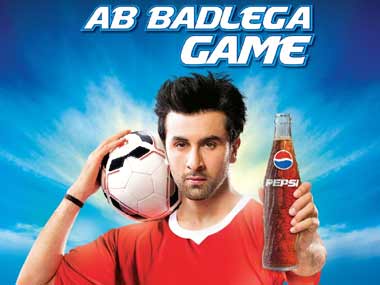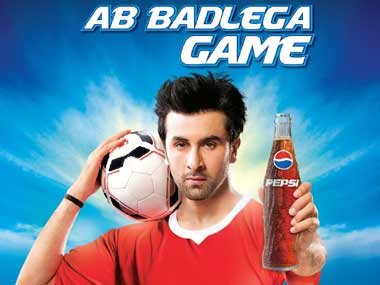Traditionally, the global cola majors, Pepsi and Coca Cola, have counted on societal trends and popular culture to connect to consumers. If consumers are besotted with films at the moment, so will the colas. If consumers are consumed by cricket, so will the colas.
Jumping onto a bandwagon, however, is expensive. The magic is to anticipate a trend; to be ahead of what will be popular. What such prescience does is to make the exercise cheaper - you get the stars before they are stars, you get consumers involved in a cultural development that is on an upward curve. Your competitor is still stuck in the current fad; your brand cuts the clutter and enjoys whole-hearted attention.
[caption id=“attachment_231615” align=“alignleft” width=“380” caption=“Actor Ranbir Kapoor in a Pepsi commercial.”]
 [/caption]
[/caption]
Yet, it takes courage to break ranks. What happens if you get it wrong?
Why is Pepsi dabbling in football with their new commercial?
What changes has Pepsi seen in the preferences of the Indian consumer that caused them to ‘change’ the game and move to football?
Not enough for Pepsi to dabble, there’s a strong statement at the end of the commercial - Change the Game, says Pepsi - a statement that suggests that this investment in football is just the beginning; more will follow.
If football is to gain, there’s another sport which will lose - and that sport is cricket.
The signs have been around. “History was created when Blackburn Rovers Football Club locked horns against I-league side Pune FC at Balewadi Sports Complex in Pune, which is also the home ground of the Pune side. The ‘Red Lizards’, as they are popularly known among their faithful, flaunt a healthy fan following in the region, but it would not be surprising to state that since the club’s inception in 2007, it was probably the first time when all the 36,000 seats in the multipurpose stadia were jam packed. The Blue and Whites were in town,” said The Hard Tackle .
Impact Shorts
More Shorts“The world’s highest rated player, Messi showed his class from the outset, as he spearheaded the moves exhibiting brilliant distribution, much to the joy of the 80,000-odd spectators at the globe’s second biggest stadium by capacity,” reported Daiji World.
In September 2011, Firstpost showed readers how the growing viewership for football was threatening cricket viewership.
In October 2011, Firstpost warned that cricket could lose to football, and you can read the warning here.
There are many indicators to suggest that Pepsi’s got it right - ahead of the competition - and Coke will have to play catch-up.
Tomorrow, I’ll be watching ESPN and STAR Sports, hoping that Liverpool beats Arsenal and that Tottenham loses to Manchester United.
And Coke will be figuring out how to deal with Pepsi.
Anant Rangaswami was, until recently, the editor of Campaign India magazine, of which Anant was also the founding editor. Campaign India is now arguably India's most respected publication in the advertising and media space. Anant has over 20 years experience in media and advertising. He began in Madras, for STAR TV, moving on as Regional Manager, South for Sony’s SET and finally as Chief Manager at BCCL’s Times Television and Times FM. He then moved to advertising, rising to the post of Associate Vice President at TBWA India. Anant then made the leap into journalism, taking over as editor of what is now Campaign India's competitive publication, Impact. Anant teaches regularly and is a prolific blogger and author of Watching from the sidelines.
)